Creating your own perfume can be a deeply rewarding and artistic endeavor. With essential oils, not only do you get the opportunity to craft unique scents tailored to your personal taste, but you also benefit from their natural and therapeutic properties. In this article, we’ll dive into how to create perfume with essential oils, exploring techniques, ingredients, blending tips, and preservation methods to help you master the art of perfumery.
Understanding the Basics of Perfume Making
What is Perfume?
Perfume is a mixture of fragrant essential oils, aroma compounds, fixatives, and solvents used to give the human body, objects, and living spaces a pleasant scent. Traditional perfumes contain alcohol and synthetic ingredients, but creating perfume with essential oils focuses on natural and botanical extracts, making them safer and often more sustainable.
Why Use Essential Oils?
Essential oils are concentrated plant extracts that capture the scent and beneficial properties of their source. Unlike synthetic fragrances, essential oils offer both aromatic and therapeutic effects, such as relaxation, stimulation, and emotional balance. When you create perfume using essential oils, you gain the advantage of a more holistic fragrance experience.
Essential Tools and Ingredients
Before you begin your perfumery journey, gather the necessary materials:
- Essential oils: Choose high-quality, pure essential oils.
- Carrier oil or alcohol: Typically jojoba oil, fractionated coconut oil, or perfumer’s alcohol.
- Glass bottles: Dark amber or cobalt blue bottles protect oils from light.
- Glass droppers or pipettes: For precise measurement.
- Blotter strips: Useful for testing scent combinations.
- Notebook: To record your formulations and observations.
Understanding Fragrance Notes
A well-balanced perfume is composed of three types of notes: top, middle, and base.
Top Notes
Top notes are the first scents you notice when you apply the perfume. They are usually light and evaporate quickly. Examples include:
- Bergamot
- Lemon
- Grapefruit
- Peppermint
Middle Notes
Middle notes form the heart of the perfume and appear once the top notes fade. They provide body and balance to the fragrance. Examples include:
- Lavender
- Geranium
- Ylang-ylang
- Rose
Base Notes
Base notes are deep, long-lasting, and form the foundation of the perfume. They help to anchor the fragrance and give it longevity. Examples include:
- Patchouli
- Sandalwood
- Vetiver
- Vanilla
When you create perfume, aim to include each of these notes in your blend for a complete aromatic profile.
How to Create Perfume with Essential Oils
Step 1: Choose Your Scent Profile
Decide on the type of perfume you want to create. Do you prefer floral, citrus, woody, spicy, or herbal scents? Start by identifying a few favorite essential oils and classify them into top, middle, and base notes.
Example combination:
- Top: Lemon
- Middle: Lavender
- Base: Patchouli
Step 2: Measure and Blend
A classic perfume ratio is:
- 30% top notes
- 50% middle notes
- 20% base notes
Using this ratio, you might blend:
- 6 drops lemon (top)
- 10 drops lavender (middle)
- 4 drops patchouli (base)
Start with a small batch, using a total of 20 drops. Blend the oils in a glass bottle and gently roll the bottle between your hands to combine.
Step 3: Add a Carrier
Once you’re happy with the scent, dilute your essential oil blend. Add about 2 tablespoons (30 ml) of carrier oil or alcohol to the blend. Carrier oil creates a roll-on perfume, while alcohol makes a sprayable scent.
Let the perfume sit for 48 hours to 6 weeks. The longer it sits, the more the scents will meld and mature.
Step 4: Test and Adjust
After the perfume has aged, test it on your skin. Notice how the fragrance changes over time, from the top notes to the lingering base. If necessary, adjust the blend by adding a few more drops of any oil to refine the scent. Always keep notes of your changes.
Tips for Successful Perfume Creation
Use High-Quality Oils
Choose 100% pure, therapeutic-grade essential oils for the best results. Avoid synthetic or diluted oils.
Work in a Clean, Dry Space
Essential oils are sensitive to contamination. Use clean glass tools and containers, and keep your workspace free of other strong smells.
Store Properly
Store your perfume in a dark glass bottle, away from heat and light. This helps preserve the integrity and longevity of the scent.
Keep a Perfume Journal
Document your recipes, proportions, aging times, and final impressions. This practice will help you track what works and inspire future creations.
Popular Essential Oil Combinations
To help you get started, here are a few inspiring perfume recipes using essential oils:
Floral Harmony
- Top: Bergamot (6 drops)
- Middle: Rose (10 drops)
- Base: Sandalwood (4 drops)
Citrus Splash
- Top: Grapefruit (7 drops)
- Middle: Geranium (9 drops)
- Base: Vetiver (4 drops)
Woodland Whisper
- Top: Cypress (5 drops)
- Middle: Lavender (10 drops)
- Base: Cedarwood (5 drops)
These combinations balance freshness, sweetness, and depth to create perfume blends that evolve beautifully on the skin.
Customizing Your Signature Scent
Perfume is a personal expression, and creating your signature scent is one of the most satisfying aspects of the craft. Consider adding small nuances such as:
- A drop of vanilla for warmth
- A hint of mint for a cooling effect
- A touch of frankincense for mystique
Experiment with layering and testing different proportions until you discover a scent that feels like your unique aromatic fingerprint.
Final Thoughts on How to Create Perfume
Learning how to create perfume with essential oils is a delightful blend of science and art. With patience and curiosity, you can craft scents that are not only beautiful but also therapeutic and deeply personal. Whether you’re making perfumes for yourself, gifts for loved ones, or launching your own natural fragrance line, the key is to start simple, experiment, and keep refining your technique.
